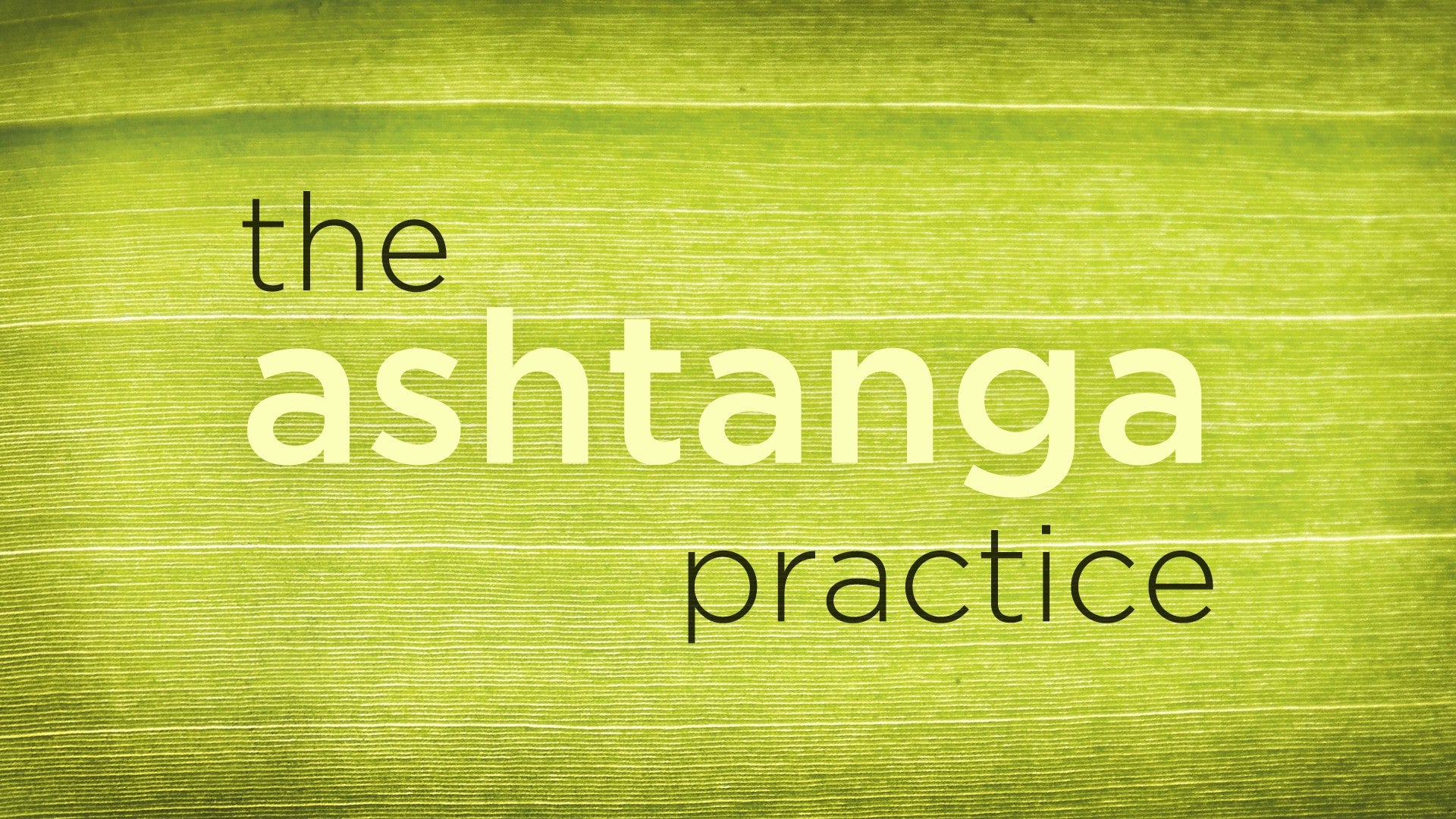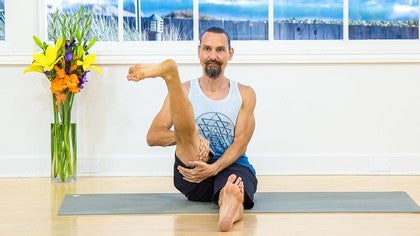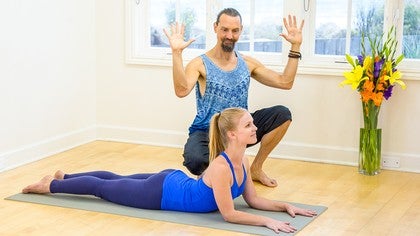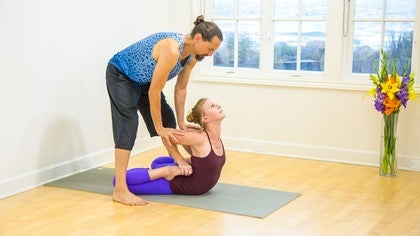Description
About This Video
Transcript
Read Full Transcript
Salutations. Let's think about our knees. The knees are a critical structure so important for us to protect. And you know in traditional yoga asana practice we really value the supreme meditation postures where we often involve crossing the legs even deeply like padmasana or full lotus or even artipadmasana. Now for some people that's going to be way too much pressure onto the knees in which case they should definitely modify and avoid any kind of knee pain. It's essential that you avoid knee pain and throughout this tutorial I'll explain why and how you can avoid knee pain. Overall most of the pain which we have in physical body any kind of pain that comes up especially in a repetitive amazing practice like ashtanga is caused by a lack of space. A lack of space between bones often and when that happens and there's a pinching on soft tissue on tendon on nerve any of that feeling that there's lack of space in joint pain should be a guide for you to realize you have the power to modify. Take responsibility for your practice. Pulling yourself into lotus in one day might work for one day but you're going to spend the rest of your life trying to recover from that. Instead slowly slowly practice and keep space between the bones. Just as we've talked about space between the breaths space between the bones will be equally important. So how can we practice avoiding pressure in the knees? Well basically the pressure in the knees comes from a lack of rotation of the thigh. So the space between the knee and the hip needs to externally rotate to allow lots of space to come into the knee joint even when drawing into a deep external rotated posture like lotus or half lotus or any of those. Why are the knees so important and why do we concern ourselves avoiding injury in the knees over all others? Basically in a nutshell injury in the knee is difficult or in some cases almost impossible to heal from. There's a very delicate structure inside on the medial side of the knee called the meniscus and it's quite easily pinched between the femur the longest bone in your body and the tibia and fibula rising up the bones of the shin. So you can imagine those bones meeting together here and if there was a lack of space they would pinch pinch pinch together squeezing that poor little medial meniscus and over a time of pinching again and again and again the meniscus might be torn. Now plenty of places in the body can heal but the meniscus is avascular that means the inside of it doesn't get blood flow. So if it doesn't get blood it doesn't get oxygen it doesn't get minerals it doesn't get prana it's very difficult if not impossible for that area to heal fully. So a stitch in time saves a million here again avoid injuring your knees. Okay how to avoid injuring your knees then? Let's think about what the knee does really well I've given you lots of doom and gloom talk about it. You can have a daily safe practice I certainly do and hopefully avoiding knee injury. The knee does this very well doesn't it? It goes backwards and forwards the condyles the heads of the bone glide over one another without any pinching. So you can practice that go ahead practice all this fun stuff at home just practice lengthening and flexing the knee at home in space. No problem right? Now how would we be able to get the foot up on the thigh with that same space between the bones external rotation of the thigh external rotation of the femur in the acetabulum in the pelvis. So come with me and try this explore this straighten one leg could be either one and flex the foot stick your heel out draw your toes back dorsiflex the foot so your toes draw back towards the shin and then from here try to keep the knee straight and externally roll the thigh maybe you can come to 90 or 100 or 110 degrees and so with that kind of rotation then I'm just going to bend the knee the same way and it comes up on the opposing thigh. So what I've done in the knee joint there is the exact same as this which hopefully you did at home and you realize that's not problematic where did the difference come it's from that rotation that external rotation of the thigh then bending the knee and I might make up a little space drawing the foot up right into the hip or even so the heel touches the abdomen. Now in that case if I have no pain pressure in the knee I know I'm pretty safe so really getting external rotation in the thighs is absolutely key to protecting your knees. Luckily daily ashtanga practice has so many externally rotated positions slowly slowly daily practice with time your hips will open your knees will be safe and you'll be approaching lotus with no rush and no attachment. A great example of one of those externally rotated positions is Janu Shishasna A which comes in the seated series so you exhale to make the posture again not just slamming into it without sense and as quickly as you can but instead finding that there's that external rotation of the thigh and you can try this with me at home even use your hands to feel that you're spinning the thigh open rolling the bottom of the thigh up towards the sky and you can bring the heel up towards the perineum towards the center of the pelvis and as you put the knee gently down towards the mat keep keep reaching keep rolling the thigh back if the knee feels pain from coming down some of you might even use a block under the knee that's fine you can always use that prop or leave the knee hanging in space that's fine but just feel that the thighs rolling open at no point should you be pushing your knee down to the mat or trying to crush down it will happen with time gently bringing the hips towards square towards the front as you exhale and fold remember this might put more pressure on the knee as well so you're slowly going down if at any point it feels like there's too much pressure or any pressure pain in the knee come up and breathe here breathing the center of your practice so if it's comfortable for you to go forward deeply into the posture then you're doing more hip opening by going forward with comfort the more forward you go the more the femur the thigh bone rolls in the acetabulum in the hip and you're doing more hip opening on both sides try the other side gently straighten the leg put yourself back into dandasana exhale bring the left foot back oh right and as you do so maybe externally roll the thigh feel like that side the top of the thighs rolling back away from you as you inhale reach forward and exhale fold looking towards the right big toe any hand positions fine any propping that you need is fine inhale come up and exhale let it go Janu Sushasana B is pretty much the same thing you'll realize if you do a longer practice with me it's where you bring the heel in towards the abdomen or sorry towards the pelvis and then lift the pelvis up off the floor and sit mula bandha down upon the heel can be more pressure on the knees so be extra careful there Janu Sushasana C however is a very interesting delicate pose we should explore in some depth now in Janu Sushasana C we're going to ask for a lot of external rotation of the thigh but you may find your medial meniscus can be more protected by understanding the tibia and the fibula roll away from the femur so there's an opening that happens in the inside of the knee so as you approach Janu Sushasana C let me guide us through it here pick up your right foot take your left palm to the right heel so your left palm grabs the right heel and then take your right hand and go under the foot reach around through and take the outside of your right big toe so your right hand has the outside of your right big toe left hand is on the heel and from there you can put a little bit of twist on the foot make sure it's feeling good in the knee of course go no further than feels good but if it's comfortable you may be able to bring all five of the right toes down onto the mat and keep the right sole of the foot onto the left thigh so that opening that's happening there though it's intense should be based around the lower leg rolling away from the meniscus and creating more space so if that feels okay you might be able to draw both hands out if it feels great and comfortable and you want more you'd be able to scoot forward eventually getting the right foot more vertical straight up and down if it feels like whoa that's going to be super difficult use your friend the block sit up upon the block right we'll build it again and that's going to give you a lot more space so then you might even just get the foot and oblique angle but at least that way you're able to find some comfort inhale reaching forward and again remember exhaling folding is asking for more hip opening so as you exhale fold you feel pain in the knee back off but that would be one way to approach that pose inhale up and exhale let it go if you're using the block you can stay with that on both sides or for the other side exhale your right hand to left heel your left hand goes under takes the outside edge of left big toe next exhale draws the foot in at your comfortable level perhaps completely vertical perhaps at an angle that's fine inhale here reaching forward and exhale folding now notice as I'm in a more full variation the knee might be off the mat for now that's fine again at no point you want to try to push the knee down it will come with time inhale up and exhale let go after I've done any kind of position where I feel like well then the hip was asked for extreme external rotation the knee might have been compromised I'll always go back to that silly little extension inflection in space because I know that I'm putting the grooves of the joint back into its natural place loves to do that there's no risk of injury in doing that as we approach lotus we start to take on half lotus arda bada padma and sometimes we do half lotus and something else like arda bada padma pashi matarasana so half lotus then as I demonstrated before extreme external rotation of a thigh you can try and do that as much as you're comfortable and draw the right foot up and it might not come all the way into the into the left hip it may just be sitting on the thigh anywhere where it's comfortable this can be a fine variation of half lotus if you're feeling like you're not sure if that's going to be comfortable on your knee make sure that it comes to a comfortable place again you could prop under the knee and think about the lotus foot the right foot in this case maybe it's dorsiflexed and that flexion and spreading the right toes on the lotus leg help to engage the arch of the foot and there's an ancient connection between the engagement of the arch the understanding of stability through the joints through the ankle through the knee and that will help to open the hip so taking the posture was a dorsiflex and spread toes may be really helpful as well as stimulating the arch outside of your yoga time yoga practice on the mat that is getting some foot massage or walking on uneven surfaces walking barefoot can be really important educate your feet and continue safety in the knee another way to encourage space between the bones there space in the joint would be to take a small towel small towel and use it as a spacer what I mean by that is take any small towel you don't want to make it too thick but usually when practicing you have a small towel with you for wiping sweat or occasionally for binding or using a prop roll it up and then place it as deeply under the knee as you can as deep inside the joint now from there still externally rolling start to bend the knee towards the art of about a Padma half bound lotus position and what's going to happen here is as you bring your foot or as you bring your your leg and your thigh into that position the spacer is going to push off of the femur and push off of the tibia and those structures will start to create more space in the joint which is what we really want after that that's what we're after there so that we have space we feel like meniscus is protected so using that spacer can help if you're getting knee pain that's cropping up deal with it don't just push through it please believe me I'd much rather see you continue this practice healthfully for a long time to come then look good for the next couple days and lotus right so using that can be really helpful if you have knee pain cropping up get into this and see if that relieves it it should really help if you're in any of the art about a Padma variations a half bound lotus binding behind the spine can help it can be a more full expression of the posture if you're bound behind the spine then notice if that caused an un-squaring of the shoulders and if that's the case gently and if it's comfortable try to drag the right shoulder back to face towards the left toe try to bring the right kidney around to the left eye so that when you go forward the shoulders have been educated to stay more or less balanced in space so you're aware of where the shoulders are again going forward requires more external rotation of the thigh the other side exhale draw the left foot in again you can use a spacer as you like you can bind as you like and exhale folding forward keeping shoulders level now again you can take any modification that serves you it may be that your artha bada Padma pashima tanasana looks like this with the left foot dorsiflexed a prop under the leg and that's fine bandha and breath and drishti the key to your practice having looked at that pose will also look at the counter pose or the next pose that occurs tree and mukha ekapada pashimata nasa so another posture that feels a little strange on the knee but creates space on the medial side you can bring the right foot back behind you so the right toes face all the way back behind you you might find the right toenail even pressing down on the mat keep try to keep that foot straight back if there's some pain or pressure on the top of the foot you could drop a towel in there so that you're not getting the bone crushing onto the mat but for most people it's fine without if you feel really really really tight in this posture just use a block under both sitting bones so elevating can help get you that correct position there and then as you go forward try to really feel the right sitting bone is grounding or rolling towards the mat avoid going to the extreme forward and letting the right sitting bone come up instead try to keep sitting bones more level inhale here and exhale folding forward if at some point you feel like you're whoa rolling over to the left side counteract that by rolling the left thigh towards the center towards the right and rolling the right thigh towards the right as well so both thighs roll to the right helping to keep that right sitting bone grounded or moving towards the mat inhale exhale let go of course the block is completely optional and it may be that you're able to take the posture absolutely comfortable without the block placing the left foot behind you left pinky toenail wants to find the mat inhale here and as you exhale both thighs here roll to the left side learning to rotate the thighs in the socket of the hip in the acetabulum to keep good integrity in the pose and good safety in the knees. Now remember our practices using these physical asanas and vinyasas are not just for glorification nor are they just for some sort of amazing energetic heroic feeling in the body all these practices have been traditionally used and perhaps designed to allow you to have a good stable steady sitting practice. So hopefully the regular daily our stronger practice that you're doing is creating openness in the hips where you're able to sit more comfortably and comfortably means using whatever is around whatever is available to you so that you can find yourself in a place where you can sit stay balanced stay in your center and breathe with space between the joints spaces between the breath.
The Ashtanga Practice: Dylan Bernstein
Comments
You need to be a subscriber to post a comment.
Please Log In or Create an Account to start your free trial.













